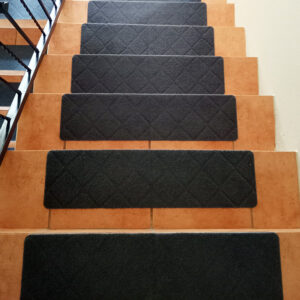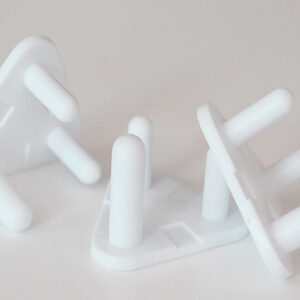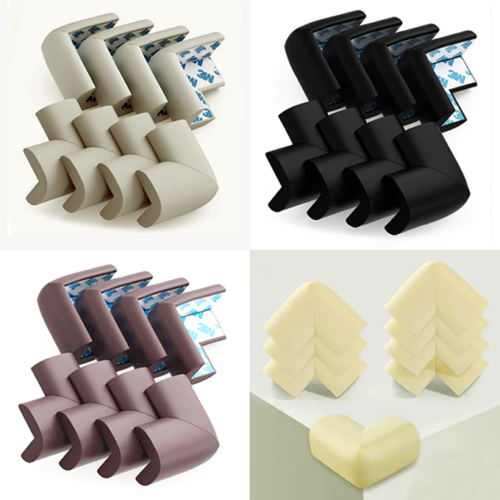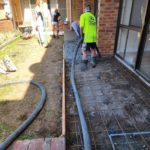Implement Effective Childproofing Techniques to Create Safe Staircases and Entrances for Your Children
Staircases present notable hazards for young children, particularly in residences that feature basements. To ensure the utmost safety for your little ones, it is essential to implement the best methods to childproof basements. This includes effectively securing staircases and entrances, creating a protective environment that significantly reduces the risk of accidents and injuries.
By taking proactive measures, parents can cultivate a safer home that greatly diminishes the likelihood of unfortunate mishaps. This dedication not only safeguards children but also provides invaluable peace of mind for parents, enabling families to relish their living spaces without the constant worry of hidden dangers lurking nearby.
Boost Child Safety by Installing Sturdy Safety Gates at Key Locations
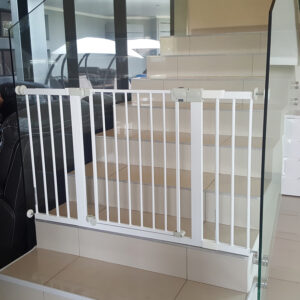 Safety gates serve as crucial barriers installed strategically at the top and bottom of basement staircases. By opting for robust safety gates, you can substantially mitigate the risk of accidental falls. When selecting safety gates, ensure they adhere to recognised safety standards and are designed for ease of use by adults while remaining challenging for toddlers to operate independently.
Safety gates serve as crucial barriers installed strategically at the top and bottom of basement staircases. By opting for robust safety gates, you can substantially mitigate the risk of accidental falls. When selecting safety gates, ensure they adhere to recognised safety standards and are designed for ease of use by adults while remaining challenging for toddlers to operate independently.
In South Africa, a variety of options are available, including pressure-mounted gates that are ideal for situations where drilling into walls is impractical. It's vital to choose a gate that is sufficiently tall and comes equipped with a childproof latch to enhance security further. Consistent maintenance and regular inspections are essential to verify these gates remain secure, especially in high-traffic areas where they are frequently in use.
By establishing an effective barrier, you not only protect inquisitive toddlers but also delineate their play areas. It’s beneficial to educate children on the significance of these safety gates, encouraging them to respect safety measures while enhancing their understanding of safe zones within the home.
Visiting local home improvement retailers in South Africa, such as Builders Warehouse or Leroy Merlin, can provide a comprehensive selection of safety gate options tailored to your specific requirements, significantly enhancing both safety and convenience within your home.
Regularly Inspect and Secure Loose Handrails for Enhanced Safety Assurance
Loose handrails on staircases can lead to severe accidents, including dangerous falls. Therefore, it is imperative to conduct thorough inspections of handrails within your basement to ensure they are securely attached and stable. The height of handrails is also crucial; they should be easily reachable for children while providing adequate support for adults.
Reinforcing handrails, if necessary, is vital to ensure they can withstand the weight of a child pulling themselves up, thereby improving safety for all users. In South Africa, characterised by various architectural styles, custom solutions for handrail installations may be needed. Engaging a qualified contractor or handyman can ensure that handrails meet safety standards while also enhancing the aesthetic appeal of your home.
Routine inspections and maintenance of handrails are crucial, as they significantly contribute to establishing a safer living environment for your children and providing reassurance to parents regarding their safety.
Implement Non-Slip Mats to Minimise Slips and Falls
Non-slip mats are indispensable for preventing slips and falls, especially on staircases and at entrances. Given South Africa's unpredictable weather, surfaces can often become slippery, elevating the risk of accidents. Investing in high-quality non-slip mats specifically designed for stair usage is essential. Look for mats featuring rubber backing to ensure they stay in place and provide the necessary grip.
These mats should also be easy to clean, as high foot traffic can lead to dirt accumulation that compromises safety. Regular checks and timely replacement of worn-out mats are vital for maintaining their effectiveness. Additionally, consider installing non-slip strips on the stairs to further improve safety. These strips not only enhance grip but also provide visual indicators for children, showing them where it is safe to step.
Ensure Sufficient Lighting to Improve Staircase and Entrance Safety
Appropriate lighting can significantly decrease the likelihood of accidents occurring on staircases and at entrances. Inadequate lighting creates a hazardous environment, particularly during nighttime when visibility is poor. Installing bright LED lights along staircases and entrances can greatly enhance safety.
Motion sensor lights offer added convenience by automatically illuminating pathways as individuals approach, ensuring these areas are well-lit at all times. Besides improving visibility, using warm-toned lights can help create a safe and welcoming atmosphere. Evaluate the lighting in your basement and consider adding extra fixtures where needed to ensure adequate illumination.
Whenever feasible, incorporating natural light through large windows or skylights can also contribute to creating safer and more inviting spaces for families and children alike.
Conduct Routine Inspections of Staircases to Uphold Safety Standards
Regular inspections of staircases are vital for upholding safety standards. Frequently check for damages such as loose steps, worn-out carpeting, or any signs of deterioration, and address these issues promptly. In South Africa, where homes face diverse weather conditions, including heavy rainfall, checking for water damage or erosion is paramount in ensuring your stairs remain safe.
Establishing a comprehensive maintenance schedule is essential to ensure your stairs remain safe throughout the year. This schedule should encompass checking for wear on handrails, confirming that non-slip mats are intact, and ensuring that lighting is functioning optimally.
Documenting any repairs or maintenance performed can help track changes over time, reinforcing that safety remains a priority in your home.
Adopt Robust Electrical Safety Measures in Your Home for Maximum Protection
Electrical safety is crucial in any household, particularly in basements where wiring may be more exposed to potential hazards. The best methods to childproof basements must include stringent electrical safety measures designed to protect children from risks that could lead to severe injuries or even fatalities.
Install Outlet Covers and Tamper-Resistant Switches for Enhanced Safety
Unprotected electrical outlets can pique children’s curiosity, often leading to dangerous situations. Installing tamper-resistant electrical outlets is a proactive step that can prevent children from inserting objects into sockets, thereby significantly reducing the risk of electric shocks. These outlets come equipped with built-in shutters that only open when a two-pronged plug is inserted, adding an essential layer of safety.
In addition to tamper-resistant outlets, consider using outlet covers for any unused sockets within your home. This straightforward yet effective solution can provide peace of mind, particularly in a basement where children may spend considerable time. Regular inspections of outlets for signs of wear or damage are essential, as frayed wires or exposed connections pose serious safety risks and should be addressed immediately.
Conceal Loose Cords and Wires to Prevent Accidents
Loose cords and wires can present both a tripping hazard and an enticing source of curiosity for children. To effectively mitigate these risks, consider employing cord concealers to hide cables along walls and baseboards. Such products can prevent children from tugging on cords, which may lead to accidents or injuries.
In South Africa, where many homes have unique layouts, investing in custom cable management solutions may be necessary to fit your space. Additionally, using furniture to obstruct access to cords can also serve as an effective strategy. Regular inspection of cords for any signs of damage or wear, along with prompt replacements, is crucial to ensure ongoing safety in your home environment.
Utilise Surge Protectors to Enhance Electrical Safety
Surge protectors are indispensable for households, especially in older homes where electrical systems may not meet modern safety standards. Installing surge protectors on all electronic devices can shield them from damage caused by power surges, which pose significant risks to both children and appliances.
These devices not only protect children from potential electrical hazards but also safeguard your appliances from damage incurred by unexpected power fluctuations. When selecting surge protectors, look for models with additional features, such as circuit breakers or warning lights, as these added layers of protection provide peace of mind. Regular checks of your surge protectors are necessary to ensure they function correctly, replacing any that show signs of wear or malfunction to maintain optimal safety.
Conduct Routine Inspections of Electrical Appliances for Safety
Electrical appliances need regular inspections to ensure they remain safe for use. Frequently examine appliances for frayed wires, damaged plugs, or any signs of overheating. Unplugging appliances when not in use and educating children on the importance of avoiding contact with these devices can help prevent accidents.
In South Africa, where load shedding can affect the performance of electrical appliances, being mindful of this can help mitigate risks. Establishing a regular check-up routine for your appliances will not only enhance their safety but also prolong their lifespan. If you discover any appliances showing signs of damage, consult a qualified electrician for necessary repairs or replacements to ensure safety standards are maintained.
Guarantee Furniture and Fixture Safety in Your Basement
The furniture and fixtures within your basement can present various hazards, especially for children exploring their surroundings. Implementing the best methods to childproof basements involves securing furniture and fixtures to prevent accidents and injuries that may arise from tipping or falling objects.
Anchor Heavy Furniture to Prevent Tipping Hazards
Securing heavy furniture is essential to prevent tipping incidents that can result in serious injuries. Items such as bookshelves, cabinets, and tall dressers should be firmly fastened to the wall to avert them from toppling over. Most hardware stores in South Africa offer anchoring kits that are straightforward to install and highly effective for this purpose.
When anchoring furniture, be sure to adhere closely to the manufacturer’s installation guidelines. Additionally, the positioning of heavy furniture is critical; avoid placing these items in areas where children can easily climb or reach them. Regularly inspect anchored furniture to confirm it remains securely fastened, checking for any signs of wear or damage that could compromise safety.
Utilise Corner Guards to Safeguard Against Sharp Edges
Sharp corners on tables and counters can lead to painful bumps and bruises for children. Installing corner guards is an effective solution to reduce this risk. These protective covers are simple to install and can absorb impact, making falls less likely to result in serious injuries. In South Africa, corner guards are available in various materials, including rubber and foam, allowing you to select an option that complements your décor while enhancing safety. Regularly check these guards for wear and replace them as necessary to maintain a secure environment for children.
Secure Cabinets and Drawers with Child-Proof Locks for Increased Safety
Child-proof locks are indispensable on cabinets and drawers containing hazardous materials or sharp objects. The installation of these locks can prevent children from accessing potentially dangerous items such as cleaning supplies, tools, or medications, thus significantly boosting safety. When selecting locks, consider options that are user-friendly for adults but challenging for children to operate. Regular assessments of these locks are essential, as wear and tear can diminish their safety features over time.
Engaging children in discussions about the dangers of specific items can further aid them in learning to respect safety boundaries within the home environment.
Implement Non-Slip Mats Under Furniture to Improve Safety
Non-slip mats should not be limited to staircases; they are equally important under furniture to prevent slipping. Placing mats beneath rugs and furniture can significantly reduce the risk of accidents by providing a stable grip on hard surfaces. Seek mats made from materials specifically designed to adhere securely and prevent slipping. In homes with children, these mats should be routinely inspected for cleanliness and signs of wear. By maintaining a tidy environment, you can prevent dirt buildup that may lead to slippery surfaces. Utilising non-slip mats enhances the overall safety of your basement, providing a stable foundation for children to play and explore.
Regularly Check Furniture Stability to Ensure Safety Assurance
Routine inspections of furniture for stability are vital to ensure it does not pose a risk to children. Wobbly tables, chairs, or benches can lead to falls and injuries. Thoroughly assess furniture, tightening screws and bolts as needed to guarantee they are secure and stable. In homes with children, teaching them safe play practices around furniture is crucial. Encouraging children to sit rather than climb on furniture will help mitigate risks associated with falls. For any furniture that exhibits considerable wear or instability, consider replacing it with more robust options designed for family use, ensuring a safer environment for everyone.
Select Suitable Flooring and Surface Materials for Enhanced Safety
The selection of flooring and surface materials in your basement can significantly influence child safety. Implementing the best methods to childproof basements involves choosing appropriate flooring solutions that minimise hazards and create a safe, welcoming space for children.
Opt for Soft Flooring to Cushion Falls and Enhance Safety
Choosing soft flooring materials, such as carpeting or padded flooring, can substantially cushion falls and decrease the likelihood of injuries. In play areas, soft surfaces provide a safer environment for children to explore without the risk of serious harm. Look for carpets or mats made from non-toxic materials that are durable and easy to clean, ensuring both safety and practicality. In South Africa, where many homes have distinctive designs, it’s vital to select flooring that complements your décor while prioritising safety. Consider options that are water-resistant, particularly in basements prone to dampness. A thoughtfully chosen flooring option can create a warm, inviting space that encourages play and exploration while ensuring safety.
Conduct Routine Hazard Inspections on Flooring to Maintain Safety
Regular inspections of flooring for hazards should be a standard practice for home safety. Loose tiles, uneven surfaces, or damaged carpeting can pose significant risks for children, leading to trips and falls. Address these issues promptly to maintain a safe play area for your family. Create a checklist for routine inspections to ensure that every surface is evaluated for potential safety hazards. If you identify any issues, consult professionals for repairs or replacements, especially in cases where extensive work is needed to restore safety standards.
Maintain Clear Floors to Prevent Trips and Falls
Keeping floors clear is essential for preventing trips and falls. Ensure that toys, clutter, and other items are not left strewn about. Encourage children to assist in tidying their play areas to instil a sense of responsibility for their surroundings, promoting a safer environment for everyone. Establishing designated storage solutions for toys can help keep the area organised. In South Africa, consider using colourful bins or crates that engage children and motivate them to put away their belongings after playtime, ensuring a neat and safe space.
Prioritise Window and Door Safety for Effective Childproofing
Windows and doors are critical areas that require special attention when childproofing a basement. The best methods to childproof basements must include effective measures to ensure that these structures do not pose risks to children, thereby providing a safe living environment.
Install Window Guards for Enhanced Child Safety
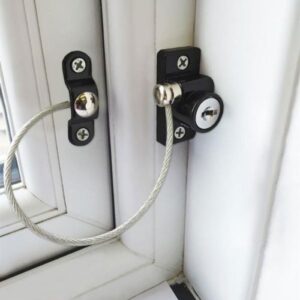 Window guards are essential safety features, particularly for ground-level windows. They prevent children from falling out while playing near open windows, significantly enhancing safety. Ensure that guards are installed according to safety guidelines and allow for easy escape in emergencies, striking a balance between security and accessibility.
Window guards are essential safety features, particularly for ground-level windows. They prevent children from falling out while playing near open windows, significantly enhancing safety. Ensure that guards are installed according to safety guidelines and allow for easy escape in emergencies, striking a balance between security and accessibility.
In South Africa, numerous security companies offer professional installation services for window guards that comply with local safety regulations. Regular inspections of these guards are crucial to ensure they remain secure and effective, promptly addressing any damages or wear to maintain optimal safety.
Utilise Door Stoppers to Prevent Injuries
Door stoppers effectively prevent doors from slamming shut, which can result in injuries, particularly to fingers. Installing these devices on interior doors, especially those leading to staircases, enhances overall safety within a home. Opt for door stoppers that are sturdy, easy to use, and suitable for your specific door types. Additionally, consider adding soft-close mechanisms to doors when feasible. This feature can offer additional safety by preventing doors from slamming shut, thus providing peace of mind for parents of young children who may be nearby.
Regularly Inspect for Broken Glass on Windows and Doors
Performing routine inspections of windows and doors for broken or cracked glass is essential for maintaining safety. Broken glass can cause severe injuries, and even minor cracks can compromise your home's safety. Immediately repair or replace any damaged glass to maintain a secure and safe environment for your family. In South Africa, where weather conditions can significantly affect the integrity of glass, proactive checks should be a standard part of home maintenance. Consulting professionals for repairs ensures adherence to safety standards, protecting your family from potential hazards.
Design a Secure and Engaging Play Area for Children
Creating a safe play area in your basement is vital for keeping children engaged and entertained without compromising their safety. Implementing the best methods to childproof basements necessitates thoughtful design choices that foster creativity while ensuring security for your little ones.
Create a Designated Safe Play Zone for Maximum Enjoyment
Establishing a specific area for play, furnished with soft furnishings and age-appropriate toys, is an excellent strategy to encourage safe play. Use rugs or soft mats to visually delineate boundaries for play zones, providing a comfortable and secure environment for children to enjoy. In South Africa, consider integrating local themes into your play area design to create an engaging atmosphere that resonates with children. Utilising colours and patterns inspired by local culture can make the space feel inviting and familiar. Regularly rotating toys can also keep the area interesting and stimulating, enhancing creativity and engagement.
Incorporate Soft Furnishings for Comfort and Safety
Introducing soft furnishings such as bean bags and cushions can create a comfortable and safe play environment. These items can absorb impact during play, making falls less likely to result in injury. Ensure that all soft furnishings are made from non-toxic materials, prioritising children’s health and safety while they play. Additionally, engage children in discussions about the boundaries of their play within the designated area. Teaching them about the importance of maintaining a tidy play space will instil a sense of responsibility for their surroundings and promote a culture of safety within the home.
Keep Hazardous Items Out of Play Areas for Maximum Safety
Ensuring that play areas are devoid of hazardous items such as tools, chemicals, or heavy objects is critical for child safety. Conduct regular checks to remove any items that could pose risks to children, maintaining a safe environment for play. Employing storage solutions with child-proof locks can further enhance safety by keeping hazardous materials securely out of reach. Designating specific storage areas for toys and ensuring that any hazardous items are stored away from play zones will create a safer and more secure environment for children to enjoy their playtime.
Effectively Prepare for Emergencies to Ensure Safety
Being prepared for emergencies is essential in any household, especially in homes with children. Implementing the best methods to childproof basements must also encompass effective emergency planning to ensure that everyone knows how to respond appropriately in various situations.
Develop a Comprehensive Emergency Plan for Your Family's Safety
Creating an extensive emergency plan ensures that all family members understand precisely what to do in different emergency scenarios, including fires, medical emergencies, and natural disasters. Regularly reviewing and practising these scenarios with children is vital, as it makes them aware of the safety protocols established to protect them. In South Africa, where natural disasters such as floods or storms can occur, tailoring your emergency plan to suit local conditions is crucial. Equip your basement with emergency kits that contain first-aid supplies, flashlights, and essential items that can be quickly accessed during a crisis, ensuring preparedness for a variety of emergencies.
Teach Children Essential Safety Protocols for Emergencies
Children must be educated about relevant safety protocols in the event of an emergency. Teaching them how to dial local emergency numbers, identify exits, and recognise potential hazards can empower them in critical situations. Role-playing emergency scenarios can help them practise these skills in a safe, controlled environment, reinforcing their understanding of safety measures. Involving children in discussions about safety encourages them to ask questions and share their concerns. This dialogue can build confidence and understanding regarding the importance of safety measures within the home, equipping them with the knowledge they need to respond effectively in emergencies.
Conduct Regular Emergency Drills to Reinforce Preparedness
Regular emergency drills are an outstanding method to reinforce preparedness within your household. Schedule yearly drills for fire safety, evacuation, or other critical scenarios to ensure that everyone knows their roles during an emergency and can respond effectively. In South Africa, consider involving local emergency services in these drills to educate children on how to react appropriately. Familiarising children with real-world emergency protocols will better prepare them to handle unexpected situations confidently and effectively, ultimately enhancing their safety and well-being.
Common Safety Questions Answered for Your Peace of Mind
What are the most effective methods to childproof basements?
The most effective methods to childproof basements include securing staircases, ensuring electrical safety, anchoring heavy furniture, using non-slip mats, and creating designated safe play areas that are free from hazards.
How can I enhance the safety of my basement stairs for children?
To enhance the safety of basement stairs, install safety gates, check for loose handrails, use non-slip mats, ensure proper lighting, and conduct regular inspections for wear and tear to maintain a safe environment.
Are there specific toys I should avoid in the basement?
It is advisable to avoid toys with small parts, sharp edges, or hazardous materials. Always ensure that toys are age-appropriate, free from any choking hazards, and safe for children to use.
What steps should I take if I discover broken glass in the basement?
If you find broken glass, immediately clear the area and ensure that children do not enter. Repair or replace the glass as soon as possible to restore safety and prevent potential injuries.
How often should I check for electrical hazards in my basement?
It is advisable to inspect your basement for electrical hazards at least every six months. Look for frayed wires, damaged plugs, and any signs of wear on electrical devices to maintain a safe environment.
What types of flooring are best for creating a child-friendly basement?
Soft flooring materials, such as carpeting or padded mats, are ideal for a child-friendly basement, as they cushion falls and provide a comfortable area for children to play safely.
How can I educate my children about safety in the basement?
Teach your children about safety by discussing the importance of staying away from hazardous areas, practising emergency drills together, and involving them in creating and adhering to safety rules within the home.
Which types of furniture should I anchor in the basement?
Anchor heavy furniture items such as bookshelves, cabinets, and dressers to the wall to prevent tipping accidents, especially in areas where children frequently play or explore.
Why is it essential to establish a designated play area in the basement?
A designated play area helps contain play activities, reducing clutter and minimising the risk of accidents while providing a safe environment for children to explore and enjoy.
What key elements should be included in an emergency plan for a basement?
An emergency plan for a basement should include evacuation routes, emergency contact information, first-aid supplies, and protocols for various emergencies such as fire or floods to ensure family safety.
Follow us for more tips on Instagram!
The article Best Ways to Childproof Basements: A Comprehensive Guide was published first on: https://www.babyproof.co.za
The Article Childproofing Basements: Top Tips for Safety Was Found On https://limitsofstrategy.com
